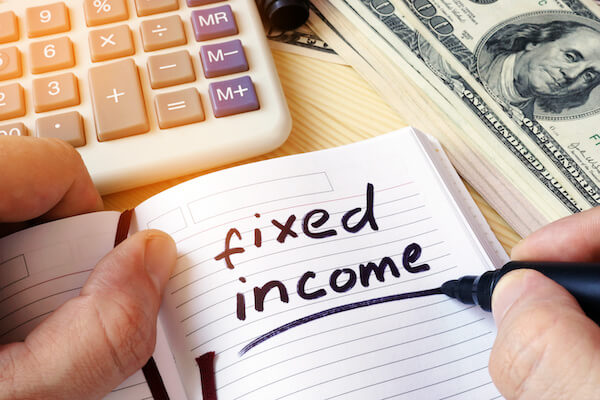
In today’s dynamically evolving economy, information about the best fixed income investments is out there but can be overshadowed by headlines about outrageous returns happening with some stocks and stock options.
For those investors approaching retirement – or those who are already retired – fixed income investments should become a more prominent consideration when thinking about portfolio allocation.
Why?
Because as we age, fixed income investing becomes increasingly important in an investment strategy that preserves capital and guarantees a stream of passive income.
Whether it’s savings accounts, government bonds, investment-grade corporate bonds, or certificates of deposit, when you find the best fixed income securities for your particular portfolio and risk tolerance, you can secure a predictable source of income. When you strike the right combination of fixed income securities and other types of investments, like stocks and mutual funds, you can create a well-diversified investment portfolio. And for you, this will mean peace of mind.
In this article, we’ll discuss what exactly fixed income investing is, look at why you should consider it, and explore a variety of fixed income investments to consider.
What Are Fixed Income Investments?
Popular fixed income securities include bonds — like corporate bonds, government bonds, U.S. Treasury bonds, and municipal bonds — as well as mortgage-backed securities and certificates of deposit (CDs).
Fixed income investments, as the name suggests, are designed to generate a predictable and “fixed” amount of interest income for investors.
Why Should I Consider Fixed Income Investing?

But aside from generating that fixed income, creating a fixed income portfolio is important for a variety of reasons. And one of the most important reasons is diversification.
You hear so much about diversification because, when done properly, it will minimize volatility within your overall portfolio performance. A diversified portfolio dilutes risk by spreading it out.
Diversification can happen by investing in different types of investments, such as growth-focused instruments like stocks and income-focused instruments like bonds. Then of course, you can further diversify by investing in different types of growth securities and different types of income securities.
The performance of bonds is gauged largely by their interest rates, and interest rates typically have an inverse relationship with the stability of the stock market. So if stocks are volatile and market prices are plummeting, you’ll tend to see interest rates rise. And vice versa.
Why?
Because investors will seek out fixed income securities when the stock market is facing periods of uncertainty and volatility. We like to think of fixed income investments as a sort of insurance policy to protect your portfolio from stock market downturns.
Fixed Income Securities Get a Bad Rap
Investors — even later-stage investors — tend to put fixed income investing on the back burner because the return from securities like CDs and bonds get a bad rap, especially when interest rates are low.
Stock returns have been proven to outpace the return on investment from fixed income securities like bonds. But here’s the interesting part: That difference is not as big as most people think — especially in the context of risk and reward.
Since the Great Depression, stocks have averaged annual returns of 10.34%. A balanced portfolio — one that combines stocks and bonds — only lags behind slightly at 9.92%. This proves that even investors who have a while to go before retirement can see excellent returns by incorporating fixed income investments into their portfolio.
Types of Fixed Income Investments
Fixed income investing has changed over time. Investors now have more options for creating a customized retirement portfolio that strikes the right balance between growth and income objectives.
Here are some of the best fixed income investments you can consider.
Bonds
Bonds are simply a loan from you to a corporation or a government entity. In return for that loan, the bond issuer will pay interest payouts at a fixed rate over time. Interest can be paid out monthly, quarterly, or semi-annually. Plus, you’ll receive your principal back at the maturity date.
For example, let’s assume you buy a 10-year bond with a face value of $10,000 that pays 3% interest. At the end of 10 years, you’ll have earned $300 per year, or $3,000 and — as long as the credit risk behind the issuer is stable — you’ll get your $10,000 back.
High-yield bonds, otherwise known as junk bonds, can offer — you guessed it! — higher yields. They get the derogatory “junk bond” name since they typically fall below investment-grade, which is a threshold that credit rating agencies assign. Investors can earn higher interest rates in exchange for assuming some extra risk.
Bond Funds
Bond funds are a nice alternative to individual bonds. You can access all the different types of bonds discussed above by investing in bond funds and bond-focused exchange-traded funds (bond ETFs).
These products select various types of bonds and bundle them into a fund. A nice benefit of a bond fund is that it enables you to diversify and spread your investment throughout the bond market all through one single investment. It’s also more liquid. Plus, one share of the ETF is typically much cheaper when compared to the cost of an actual bond, so it’s much easier to get started.
Certificates of Deposit
Safe haven. Those two words conjure up a nice feeling, don’t they?
Certificates of Deposit (CDs) are considered safe-haven investments because they limit and almost nullify your risk of principal loss. Just like a loan that pays interest, the investor acts as the lender and the other party — typically a bank or a credit union — benefits from the loaned cash and pays interest in return.
In return for this cozy safe haven, however, CDs only pay very modest returns. The returns are only a stone’s throw from returns you’d see in a traditional savings account.
High-Yield Online Savings Accounts
Online savings accounts generally provide higher rates of return than you’d see from a traditional savings account.
Why?
Because traditional brick-and-mortar banks have lots of overhead that eat into your returns. High-yield online savings accounts don’t.
Plus, online banks need a way to engage new customers. They want to attract you and your money, so they will offer higher yields than your local bank.
The downside is that the returns, although better than traditional banks, are still quite low. Although high-yield online savings accounts offer liquidity, be sure to consider that you’ll likely be limited to a certain number of transactions per month.
Taking the Next Step: Adding the Best Fixed Income Investments to Your Portfolio

Make no mistake. We’re not focusing on the short term or big payoffs here. The best fixed income investments are long-term instruments. As the saying goes, slow and steady wins the race. That’s got to count for something.
Successful investing for the modern fixed income portfolio will consider how long you have until retirement as well as the risks and rewards in today’s rapidly changing world.
But now that you know what fixed income investments are, what purpose they can serve now and in retirement, and a few of the options out there, you’re ready to begin diversifying your portfolio to include them.





